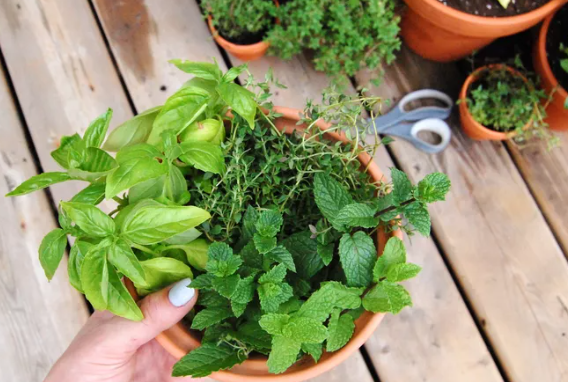The herbs from your garden are best when used fresh, but there are always more than you can use in one season. Dried herbs from your garden offer the next best thing to fresh. Air drying is not only the easiest and least expensive way to dry fresh herbs, but this slow drying process can also help retain the essential oils of the herbs, which helps to maintain their fl
Air drying works best with herbs that do not have a high moisture content, like bay, dill, angelica, marjoram, oregano, rosemary, summer savory, and thyme. To retain the best flavor of these herbs, you’ll either need to allow them to dry naturally or use a food dehydrator. A microwave or an oven set on low may seem like a convenient shortcut, but they actually cook the herbs to a degree, diminishing the oil content and flavor. Use these appliances only as a last resort.
If you want to preserve herbs with succulent leaves or a high moisture content, such as basil, chives, mint, and tarragon, you can try drying them with a dehydrator, but for the best flavor retention, consider freezing them. It’s easy to do and even quicke
When you’re ready to make a final trimming of your herbs for the season:
:max_bytes(150000):strip_icc():format(webp)/1DryingHerbs_Hero-08018f3af04341e5936ec8bf8f90a02f.jpg)
- Harvest herbs before they flower for the fullest flavor. If you’ve been harvesting branches all season, your plants probably never get a chance to flower. However, by late summer, even the herbs that have not yet flowered will start to decline as the weather cools. This is a good time to begin harvesting and drying your herbs.
- Cut branches in mid-morning. Let the morning dew dry from the leaves but pick before the plants are wilting in the afternoon sun.
- Do not cut the entire plant, unless you plan on replacing it. You should never cut back by more than 2/3 or remove more than about 1/3 of a plant’s branches at one time.
Once dried and stored in airtight containers, herbs will retain good flavor for up to one year.
- Paper bag
- Container labels
- Paper towels
-
Gather the clippings you wish to dry.
:max_bytes(150000):strip_icc():format(webp)/how-to-dry-and-store-herbs-1403397-FINAL2-73e80053c83448599f7f85b8128112ab.png)
-
Shake the branches gently to remove any insects. There are always hitchhikers, and since you won’t be thoroughly washing the stems, get rid of as many as you can right now
-
If you’ve picked your herbs while the plants are dry, you should be able to simply shake off any excess soil. Rinse with cool water only if necessary and pat dry with paper towels. Hang or lay the herb branches out where they will get plenty of air circulation so they can dry out quickly. Wet herbs will mold and rot.
-
Remove the lower leaves along the bottom inch or so of the stem. You can use these leaves fresh or dry them separately. Remove any dry or diseased leaves from the cut herbs during this time. Yellowed leaves and leaves spotted by disease are not worth drying. Their flavor has already been diminished by the stress of the season.
-
Bundle four to six stems together and tie them as a bunch. You can either use a string or a rubber band. The bundles will shrink as they dry and the rubber band will loosen, so check periodically to make sure that the bundle is not slipping. If you are trying to dry herbs that have high water content, make small bundles so they get air flowing between the branches and do not rot.
-
Though this step isn’t completely necessary, some find that paper bags aid in drying out the herbs more quickly and thoroughly. Punch or cut holes in a paper bag, and place the bundled herbs inside, upside down. Secure the bag by gathering the end around the bundle and tying it closed. Make sure the herbs are not crowded inside the bag. Label the bag with the name of the herb you are drying.
-
The oldest way to dry herbs is to take a bunch, hang it upside down in a warm, airy room and let nature do the work.
Once you’ve completed the drying process:
-
Discard any dried herbs that show the slightest sign of mold. It will only spread.
:max_bytes(150000):strip_icc():format(webp)/2DryingHerbs_Harvesting-1ebcfa71887a4ee3a87c9d525e42ce9a.jpg)
-
Store your dried herbs in airtight containers. Small canning jars work nicely. Zippered plastic bags will work, as well. Your herbs will retain more flavor if you store the leaves whole and crush them when you are ready to use them.
-
Label and date your containers
:max_bytes(150000):strip_icc():format(webp)/how-to-dry-and-store-herbs-1403397-02-1352b623a3044d1893f300e7af801670.jpg)
-
Place containers in a cool, dry place away from direct sunlight. You can choose amber-colored canning jars that are designed to block sunlight.





